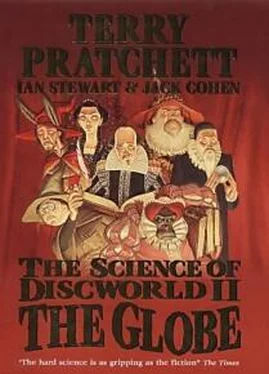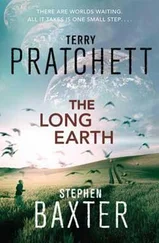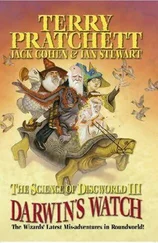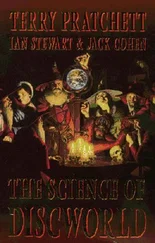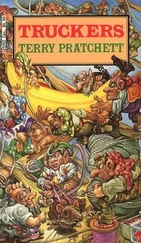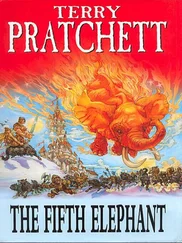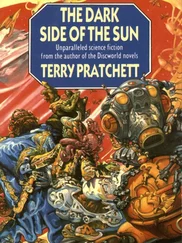Terry Pratchett - The Globe
Здесь есть возможность читать онлайн «Terry Pratchett - The Globe» весь текст электронной книги совершенно бесплатно (целиком полную версию без сокращений). В некоторых случаях можно слушать аудио, скачать через торрент в формате fb2 и присутствует краткое содержание. Жанр: Фантастика и фэнтези, на английском языке. Описание произведения, (предисловие) а так же отзывы посетителей доступны на портале библиотеки ЛибКат.
- Название:The Globe
- Автор:
- Жанр:
- Год:неизвестен
- ISBN:нет данных
- Рейтинг книги:3 / 5. Голосов: 1
-
Избранное:Добавить в избранное
- Отзывы:
-
Ваша оценка:
- 60
- 1
- 2
- 3
- 4
- 5
The Globe: краткое содержание, описание и аннотация
Предлагаем к чтению аннотацию, описание, краткое содержание или предисловие (зависит от того, что написал сам автор книги «The Globe»). Если вы не нашли необходимую информацию о книге — напишите в комментариях, мы постараемся отыскать её.
The Globe — читать онлайн бесплатно полную книгу (весь текст) целиком
Ниже представлен текст книги, разбитый по страницам. Система сохранения места последней прочитанной страницы, позволяет с удобством читать онлайн бесплатно книгу «The Globe», без необходимости каждый раз заново искать на чём Вы остановились. Поставьте закладку, и сможете в любой момент перейти на страницу, на которой закончили чтение.
Интервал:
Закладка:
It's a bit like a picture on a computer screen. If you look at it from a distance, you can see cows and trees and all kinds of structure. But if you look sufficiently closely at a tree, all you see is one uniformly green square, or pixel. A real tree would still have detailed structure at this scale leaves and twigs, say -but in the picture all this detail is smeared out into the same shade of green.
In this approximation, once 'order' has disappeared below the level of the coarse-graining, it can never come back. Once a pixel has been smeared, you can't unsmear it. In the real universe, though, it sometimes can, because in the real universe the detailed motion inside the boxes is still going on, and a smeared-out average ignores that detail. So the model and the reality are different. Moreover, this modelling assumption treats forward and backward time asymmetrically. In forward time, once a molecule goes into a box, it can't escape. In contrast, in a time-reversal of this model it can escape from a box but it can never get in if it wasn't already inside that box to begin with.
This explanation makes it clear that the Second Law of Thermodynamics is not a genuine property of the universe, but merely a property of an approximate mathematical description.
Whether the approximation is helpful or not thus depends on the context in which it is invoked, not on the content of the Second Law of Thermodynamics. And the approximation involved destroys any relation with Newton's laws, which are inextricably linked to that fine detail. Now, as we said, Shannon used the same word 'entropy' for his measure of the structure introduced by statistical patterns in an information source. He did so because the mathematical formula for Shannon's entropy looks exactly the same as the formula for the thermodynamic concept. Except for a minus sign. So thermodynamic entropy looks like negative Shannon entropy: that is, thermodynamic entropy can be interpreted as 'missing information'. Many papers and books have been written exploiting this relationship -attributing the arrow of time to a gradual loss of information from the universe, for instance. After all, when you replace all that fine detail inside a box by a smeared-out average, you lose information about the fine detail. And once it's lost, you can't get it back. Bingo: time flows in the direction of information-loss.
However, the proposed relationship here is bogus. Yes, the formulas look the same ... but they apply in very different, unrelated, contexts. In Einstein's famous formula relating mass and energy, the symbol c represents the speed of light. In Pythagoras's Theorem, the same letter represents one side of a right triangle. The letters are the same, but nobody expects to get sensible conclusions by identifying one side of a right triangle with the speed of light. The alleged relationship between thermodynamic entropy and negative information isn't quite that silly, of course. Not quite.
As we've said, science is not a fixed body of 'facts', and there are disagreements. The relation between Shannon's entropy and thermodynamic entropy is one of them. Whether it is meaningful to view thermodynamic entropy as negative information has been a controversial issue for many years. The scientific disagreements rumble on, even today, and published, peer-reviewed papers by competent scientists flatly contradict each other.
What seems to have happened here is a confusion between a formal mathematical setting in which 'laws' of information and entropy can be stated, a series of physical intuitions about heuristic interpretations of those concepts, and a failure to understand the role of context. Much is made of the resemblance between the formulas for entropy in information theory and thermodynamics, but little attention is paid to the context in which those formulas apply. This habit has led to some very sloppy thinking about some important issues in physics.
One important difference is that in thermodynamics, entropy is a quantity associated with a state of the gas, whereas in information theory it is defined for an information source: a system that generates entire collections of states ('messages'). Roughly speaking, a source is a phase space for successive bits of a message, and a message is a trajectory, a path, in that phase space. In contrast, a thermodynamic configuration of molecules is a point in phase space. A specific configuration of gas molecules has a thermodynamic entropy, but a specific message does not have a Shannon entropy. This fact alone should serve as a warning. And even in information theory, the information 'in' a message is not negative information-theoretic entropy. Indeed the entropy of the source remains unchanged, no matter how many messages it generates.
There is another puzzle associated with entropy in our universe. Astronomical observations do not fit well with the Second Law. On cosmological scales, our universe seems to have become more complex with the passage of time, not less complex. The matter in the universe started out in the Big Bang with a very smooth distribution, and has become more and more clumpy -more and more complex -with the passage of time. The entropy of the universe seems to have decreased considerably, not increased. Matter is now segregated on a huge range of scales: into rocks, asteroids, planets, stars, galaxies, galactic clusters, galactic superclusters and so on. Using the same metaphor as in thermodynamics, the distribution of matter in the universe seems to be becoming increasingly ordered. This is puzzling since the Second Law tells us that a thermodynamic system should become increasingly disordered.
The cause of this clumping seems to be well established: it is gravity. A second time-reversibility paradox now rears its head. Einstein's field equations for gravitational systems are time- reversible. This means that if any solution of Einstein's field equations is time-reversed, it becomes an equally valid solution. Our own universe, run backwards in this manner, becomes a gravitational system that gets less and less clumpy as time passes -so getting less clumpy is just as valid, physically, as getting more clumpy. Our universe, though, does only one of these things: more clumpy.
Paul Davies's view here is that 'as with all arrows of time, there is a puzzle about where the asymmetry comes in ... The asymmetry must therefore be traced to initial conditions'. What he means here is that even with time-reversible laws, you can get different behaviour by starting the system in a different way. If you start with an egg and stir it with a fork, then it scrambles. If you start with the scrambled egg, and very very carefully give each tiny particle of egg exactly the right push along precisely the opposite trajectory, then it will unscramble. The difference lies entirely in the initial state, not in the laws. Notice that 'stir with a fork' is a very general kind of initial condition: lots of different ways to stir will scramble the egg. In contrast, the initial condition for unscrambling an egg is extremely delicate and special.
In a way this is an attractive option. Our clumping universe is like an unscrambling egg: its increasing complexity is a consequence of very special initial conditions. Most 'ordinary' initial conditions would lead to a universe that isn't clumped -just as any reasonable kind of stirring leads to a scrambled egg. And observations strongly suggest that the universe's initial conditions at the time of the Big Bang were extremely smooth, whereas any 'ordinary' state of a gravitational system presumably should be clumped. So, in agreement with the suggestion just outlined, it seems that the initial conditions of the universe must have been very special -an attractive proposition for those who believe that our universe is highly unusual, and ditto for our place within it.
From the Second Law to God in one easy step.
Читать дальшеИнтервал:
Закладка:
Похожие книги на «The Globe»
Представляем Вашему вниманию похожие книги на «The Globe» списком для выбора. Мы отобрали схожую по названию и смыслу литературу в надежде предоставить читателям больше вариантов отыскать новые, интересные, ещё непрочитанные произведения.
Обсуждение, отзывы о книге «The Globe» и просто собственные мнения читателей. Оставьте ваши комментарии, напишите, что Вы думаете о произведении, его смысле или главных героях. Укажите что конкретно понравилось, а что нет, и почему Вы так считаете.
